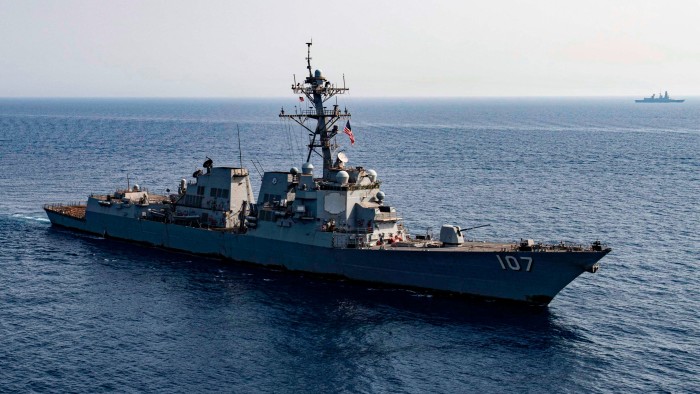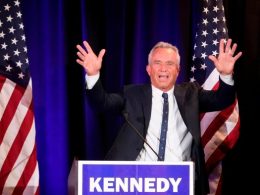The Pentagon is deploying warships to waters around Central and South America, an unusually large naval build-up that has stoked tensions with Venezuela and other Latin American countries.
The US Navy has sent at least seven vessels, including three guided-missile destroyers, an amphibious assault ship and a guided-missile cruiser, according to people familiar with the matter. A nuclear-powered fast attack submarine has also been deployed, according to one person.
The Trump administration has billed the move, which involves thousands of sailors and marines, as part of its efforts to combat drug trafficking by cartels.
The White House has used increasingly hostile rhetoric about Venezuela’s President Nicolás Maduro, referring to him as “illegal” and accusing him of trafficking drugs.
Maduro called up militiamen in response to the US deployment, while Colombian President Gustavo Petro has suggested his country’s armed forces could support Venezuela if it is attacked.
Asked whether the US was planning to deploy troops in Venezuela, White House press secretary Karoline Leavitt said last week that Trump was “prepared to use every element of American power to stop drugs from flooding into our country”.
She added that Maduro was “not a legitimate president”.
“He is a fugitive head of this cartel,” she said.
Pentagon spokesperson Sean Parnell said the US counter-narcotics effort needed “a whole-of-government effort and through co-ordination with regional partners”, adding that Trump was seeking to “eliminate the ability of these cartels to threaten the [US’s] territory, safety, and security”.
The Pentagon would not speculate on future operations, he added.
But analysts said the scale of the deployment suggested the US operation may go beyond its stated focus on drugs trafficking.
“This is a force whose nature and size is not consistent with counter-drug operations,” said Evan Ellis, a member of former secretary of state Mike Pompeo’s staff in Trump’s first administration.
“The logical mission would be a snatch-and-grab operation to bring Maduro to justice,” he added, though he cautioned that he was not convinced Trump was “committed to pulling the trigger on it yet”.
Two warships, the USS Jason Dunham and USS Gravely, are now off Venezuela’s coast, said a person familiar with the mission. A third guided missile destroyer, the USS Sampson, is currently in the Pacific just south of Panama, said a US official.
The amphibious assault ship USS Iwo Jima and two supporting vessels, carrying more than 4,500 military personnel in total, are also on their way to the region, according to the person familiar.
The US Navy is also deploying the guided missile cruiser USS Lake Erie and the nuclear submarine USS Newport News to the region, the person said.
Five of the eight vessels are equipped with Tomahawk missiles, which can hit land targets.
Trump has taken an aggressive stance on alleged foreign drug operations, signing an executive order early in his second term designating some drug cartels as foreign terrorist organisations.
His administration’s policy on Venezuela has zigzagged between verbal attacks on Maduro and behind-the-scenes negotiations for hostage releases and oil deals with Caracas.
Ellis, who teaches at the US Army War College, said the composition of the force headed for waters off Venezuela would allow Washington to put “a lot of forces on the ground pretty quickly” via air and sea.
The size of the deployment has evoked memories of US missions to Haiti in 1994 to remove the military regime led by Raoul Cédras and in Panama to depose General Manuel Noriega in 1989.
Maduro, a revolutionary socialist, began his third term in January after an election last year that was widely regarded as fraudulent.
He has given a series of combative speeches in recent days in response to the US-build up, and claimed to have called up 4.5mn militia members to defend the country.
“We bow to no one — not today, not ever,” Maduro said on Wednesday. “Let it be clear: we will never accept anyone else’s supremacy over us.”
On Tuesday, Venezuela’s defence minister Vladimir Padrino López announced a naval deployment to waters near the country’s main oil hub. The governments of Guyana and Trinidad and Tobago, which neighbour Venezuela, have endorsed the US deployment. Venezuela claims two-thirds of Guyana’s territory, and previously sent naval patrols to contested waters.
“You cannot trust Maduro,” Guyana’s vice-president Bharrat Jagdeo told the Financial Times. The flow of drugs to the US justified Washington’s “enhanced presence” in the areas, he added.
Colombia’s leader Petro has publicly aligned with Maduro and suggested that any attack on Venezuela would be tantamount to an attack on Latin America and the Caribbean. He later moderated his position.
“It is false that we want to unite the Colombian and Venezuelan armies,” Petro said in a speech on August 12. “What we want is to co-ordinate the fight against drug trafficking.”
Source link









